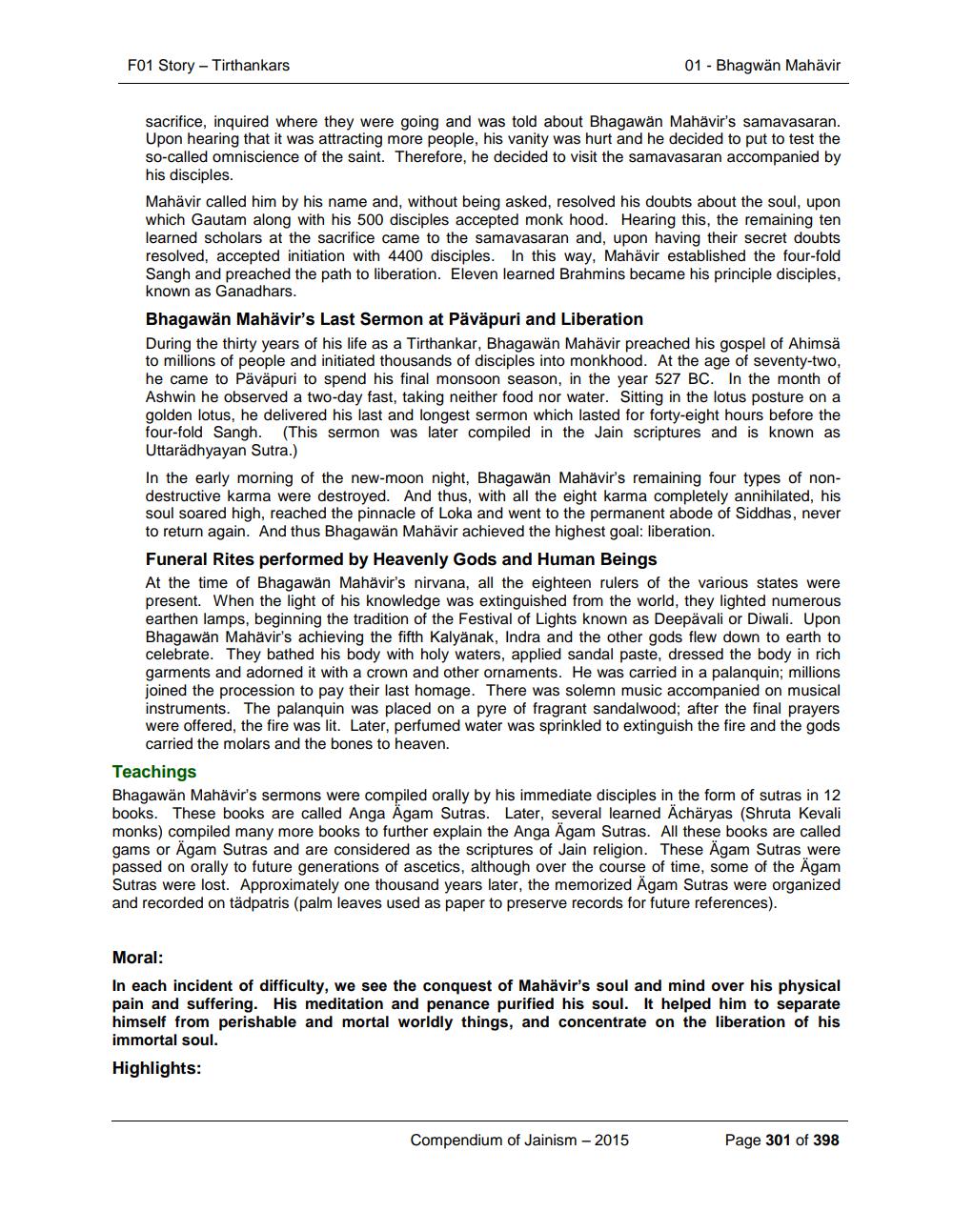________________
F01 Story - Tirthankars
01 - Bhagwan Mahävir
sacrifice, inquired where they were going and was told about Bhagawan Mahävir's samavasaran. Upon hearing that it was attracting more people, his vanity was hurt and he decided to put to test the so-called omniscience of the saint. Therefore, he decided to visit the samavasaran accompanied by his disciples. Mahävir called him by his name and, without being asked, resolved his doubts about the soul, upon which Gautam along with his 500 disciples accepted monk hood. Hearing this, the remaining ten learned scholars at the sacrifice came to the samavasaran and, upon having their secret doubts resolved, accepted initiation with 4400 disciples. In this way, Mahävir established the four-fold Sangh and preached the path to liberation. Eleven learned Brahmins became his principle disciples, known as Ganadhars. Bhagawan Mahävir's Last Sermon at Päväpuri and Liberation During the thirty years of his life as a Tirthankar, Bhagawan Mahävir preached his gospel of Ahimsä to millions of people and initiated thousands of disciples into monkhood. At the age of seventy-two, he came to Päväpuri to spend his final monsoon season, in the year 527 BC. In the month of Ashwin he observed a two-day fast, taking neither food nor water. Sitting in the lotus posture on a golden lotus, he delivered his last and longest sermon which lasted for forty-eight hours before the four-fold Sangh. (This sermon was later compiled in the Jain scriptures and is known as Uttaradhyayan Sutra.) In the early morning of the new-moon night, Bhagawan Mahavir's remaining four types of nondestructive karma were destroyed. And thus, with all the eight karma completely annihilated, his soul soared high, reached the pinnacle of Loka and went to the permanent abode of Siddhas, never to return again. And thus Bhagawan Mahävir achieved the highest goal: liberation. Funeral Rites performed by Heavenly Gods and Human Beings At the time of Bhagawan Mahävir's nirvana, all the eighteen rulers of the various states were present. When the light of his knowledge was extinguished from the world, they lighted numerous earthen lamps, beginning the tradition of the Festival of Lights known as Deepävali or Diwali. Upon Bhagawan Mahävir's achieving the fifth Kalyänak, Indra and the other gods flew down to earth to celebrate. They bathed his body with holy waters, applied sandal paste, dressed the body in rich garments and adorned it with a crown and other ornaments. He was carried in a palanquin; millions joined the procession to pay their last homage. There was solemn music accompanied on musical instruments. The palanquin was placed on a pyre of fragrant sandalwood; after the final prayers were offered, the fire was lit. Later, perfumed water was sprinkled to extinguish the fire and the gods carried the molars and the bones to heaven.
Teachings Bhagawan Mahävir's sermons were compiled orally by his immediate disciples in the form of sutras in 12 books. These books are called Anga Agam Sutras. Later, several learned Acharyas (Shruta Kevali monks) compiled many more books to further explain the Anga Agam Sutras. All these books are called gams or Agam Sutras and are considered as the scriptures of Jain religion. These Agam Sutras were passed on orally to future generations of ascetics, although over the course of time, some of the Agam Sutras were lost. Approximately one thousand years later, the memorized Agam Sutras were organized and recorded on tädpatris (palm leaves used as paper to preserve records for future references).
Moral: In each incident of difficulty, we see the conquest of Mahävir's soul and mind over his physical pain and suffering. His meditation and penance purified his soul. It helped him to separate himself from perishable and mortal worldly things, and concentrate on the liberation of his immortal soul. Highlights:
Compendium of Jainism - 2015
Page 301 of 398




